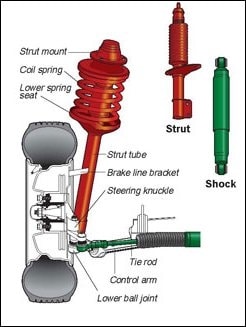What Are Shocks and Struts?
Shocks and struts influence the control and handling characteristics of your vehicle while holding the tires to the road. They control the action of the spring to resist bottoming out -- like when you hit a pothole -- and keep the movement of the springs under control when they rebound. Without shocks and struts, a vehicle would continually bounce and bound down the road, making driving difficult.

"It is important that shocks and struts are in top condition during the winter months," says James Plogger, vice president of sales for Gabriel Ride Control Products, Inc. "It is recommended that vehicle owners have their vehicles' ride control systems checked by a certified service technician." All of Stanley Subaru's Service Technicians are Certified Subaru Technicians and Certified Subaru Master Technicians.
How Do Shocks and Struts Work?
Shocks provide resistance by forcing hydraulic fluid (oil) through valves in the piston as it moves up and down. Because the oil cannot be compressed, only a certain amount of fluid can be forced through these valves, which creates resistance to the vehicle movement.
eHow has a fabulous video that clearly shows how shocks and struts work. Check it out! What Are Shocks and Struts, and How Do They Work? -- powered by eHow.
How Do You Know if Shocks and Struts Need Replacement?
Under normal conditions, shocks and struts wear out gradually. However, many factors can affect how much wear is actually occurring and at what rate it is occurring.
"For example, two people buy the same vehicle new off the dealer lot -- one lives in the city close to the office, and drives mostly on straight roads. The other lives in the country, 45 miles from the office and must travel 10 of those miles on a winding, often muddy gravel road. Because shocks operate in an extremely hostile under-vehicle environment, where anything from gravel to ice, and snow to grit can affect the life of the product, it is a good bet that driver number two will need to replace his shocks long before driver number one," explains Plogger.
The piston rod can easily be nicked or damaged by flying gravel allowing grit and dirt to damage the piston seal.
What Are the Signs of Worn Shocks or Struts?
Do you experience excessive bounce (three or more bounces) when crossing an intersection? When stopping quickly does your vehicle rock back and forth? While applying your brakes firmly at higher speeds, does your vehicle drift left or right? When changing lanes quickly does your vehicle rock or sway from side to side?
Many components contribute to handling. Having your vehicle inspected if you experience any of the above signs is good preventive maintenance. Contact Stanley Subaru's Service Center to make an appointment by calling 800-437-8989 or make your appointment online and save $5 off your next visit!
Sources:
1.http://www.subaru.com/owners/resource-center/vehicle-care-tips/article.html?uri=/owners/resource-center/vehicle_care_tips/posts/05232011_0000/&tq=posts/vehicle-care-tips/posts/05232011_0000/&tq=posts/vehicle-care-tips. http://rally.subaru.com/: Ask the Subaru Rally Team "What Shocks and Struts Do" written May 23, 2011.
2. www.eHow.com. eHow video: "What are Shocks and Struts and How Do They Work" http://www.ehow.com/video_6886548_shocks-struts_-do-work_.html.
3. Shocks and struts photo/diagram by Auto Repair Help http://www.auto-repair-help.com/automotive_maintenance/shocks_struts.php.



